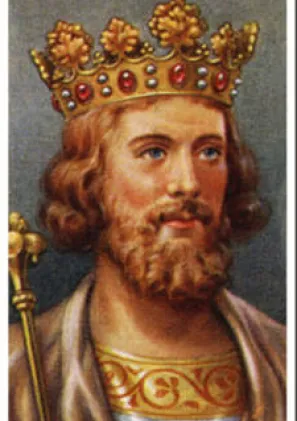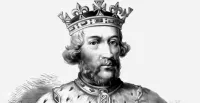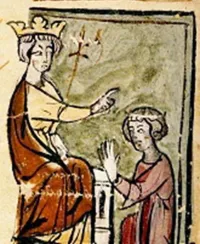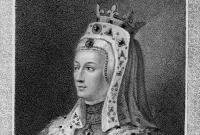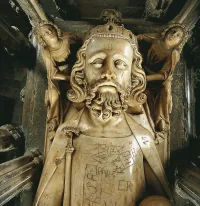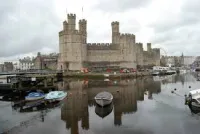Biography
1284 - 1327
King Edward II’s controversial reign was marked by an intractable war with Scotland and dissention within the ranks of his own nobility that lead to his murder in 1327. But his real troubles began with his affection for Piers Gaveston. Though they had already met and fallen in love before Edward was crowned, when he became king his nobles came to violently resent Gaveston’s influence and the power it gave him. As a result they engineered Gaveston’s death in 1312. In later centuries, Edward’s and Gaveston’s doomed romance would become a recurring subject in popular culture, but in their day it was characterized by the concept of a sworn or ‘wedded’ brother. Wedded brotherhood was a ritualized form of voluntary kinship that often involved Mass and Holy Communion – similar in rite to marriage – though the Church would not have sanctioned same-sex marriage per se. In spite of the fact that Edward was married and had fathered several children, the chronicle of Meaux Abbey, founded in 1151, firmly records that the relationship between he and Gaveston was homosexual in nature and that Edward clearly loved him with great passion. It is difficult to know how common such relationships were, but wedded brotherhood extended across society as far down as peasant farmers and was intended to endure alongside subsequent ties, including those of marriage. For most people wedded brotherhood fit quietly into the social matrix and remained a feature of English society well into the 17th-century. Surviving monuments that dot the English countryside serve as historical reminders of the now mostly-forgotten social construct that the love of King Edward II and Piers Gaveston has come to represent.
1284 - 1327
King Edward II’s controversial reign was marked by an intractable war with Scotland and dissention within the ranks of his own nobility that lead to his murder in 1327. But his real troubles began with his affection for Piers Gaveston. Though they had already met and fallen in love before Edward was crowned, when he became king his nobles came to violently resent Gaveston’s influence and the power it gave him. As a result they engineered Gaveston’s death in 1312. In later centuries, Edward’s and Gaveston’s doomed romance would become a recurring subject in popular culture, but in their day it was characterized by the concept of a sworn or ‘wedded’ brother. Wedded brotherhood was a ritualized form of voluntary kinship that often involved Mass and Holy Communion – similar in rite to marriage – though the Church would not have sanctioned same-sex marriage per se. In spite of the fact that Edward was married and had fathered several children, the chronicle of Meaux Abbey, founded in 1151, firmly records that the relationship between he and Gaveston was homosexual in nature and that Edward clearly loved him with great passion. It is difficult to know how common such relationships were, but wedded brotherhood extended across society as far down as peasant farmers and was intended to endure alongside subsequent ties, including those of marriage. For most people wedded brotherhood fit quietly into the social matrix and remained a feature of English society well into the 17th-century. Surviving monuments that dot the English countryside serve as historical reminders of the now mostly-forgotten social construct that the love of King Edward II and Piers Gaveston has come to represent.
Demography
Demography
Gender Male
Sexual Orientation Bisexual
Gender Identity Cisgender
Ethnicity Caucasian/White
Faith Construct Catholic
Nations Affiliated United Kingdom
Era/Epoch Middle Ages/ Medieval Period (476-1500)
Field(s) of Contribution
Diplomacy
Military
Politics
Royalty
Commemorations & Honors
Crowned King of England (1307)
Demography
Gender Male
Sexual Orientation Bisexual
Gender Identity Cisgender
Ethnicity Caucasian/White
Faith Construct Catholic
Nations Affiliated United Kingdom
Era/Epoch Middle Ages/ Medieval Period (476-1500)
Field(s) of Contribution
Diplomacy
Military
Politics
Royalty
Commemorations & Honors
Crowned King of England (1307)
Resources
Resources
Bray, Alan. "Edward II." Who's Who in Gay and Lesbian History from Antiquity to World War II. Robert Aldrich and Garry Wotherspoon, eds. London: Routledge, 2001. 141-42.
Bredbeck, Gregory. Sodomy and Interpretation: Marlowe to Milton. Ithaca: Cornell University Press, 1991.
Chaplais, Pierre. Piers Gaveston: Edward II's Adoptive Brother. Oxford, Clarendon Press, 1994.
Hammond, Paul. Figuring Sex between Men from Shakespeare to Rochester. Oxford: Clarendon Press, 2002.
Prestwich, Michael. The Three Edwards: War and State in England 1272-1377. London: Weidenfeld and Nicolson, 1980.
Raban, Sandra. England under Edward I and Edward II 1259-1327. Malden, Mass.: Blackwell Publishers, 2000.
Warner, Kathryn. Edward II: The Unconventional King. Gloucestershire: Amberley Publishing, 2015.
https://en.wikipedia.org/wiki/Edward_II_of_England
https://www.nndb.com/people/710/000093431/
https://www.bbc.co.uk/blogs/wales/entries/80f525dc-64dd-30a1-930c-cc6af…
https://www.creativehistorian.co.uk/blog/read_123643/wedding-of-edward-…
Resources
Bray, Alan. "Edward II." Who's Who in Gay and Lesbian History from Antiquity to World War II. Robert Aldrich and Garry Wotherspoon, eds. London: Routledge, 2001. 141-42.
Bredbeck, Gregory. Sodomy and Interpretation: Marlowe to Milton. Ithaca: Cornell University Press, 1991.
Chaplais, Pierre. Piers Gaveston: Edward II's Adoptive Brother. Oxford, Clarendon Press, 1994.
Hammond, Paul. Figuring Sex between Men from Shakespeare to Rochester. Oxford: Clarendon Press, 2002.
Prestwich, Michael. The Three Edwards: War and State in England 1272-1377. London: Weidenfeld and Nicolson, 1980.
Raban, Sandra. England under Edward I and Edward II 1259-1327. Malden, Mass.: Blackwell Publishers, 2000.
Warner, Kathryn. Edward II: The Unconventional King. Gloucestershire: Amberley Publishing, 2015.
https://en.wikipedia.org/wiki/Edward_II_of_England
https://www.nndb.com/people/710/000093431/
https://www.bbc.co.uk/blogs/wales/entries/80f525dc-64dd-30a1-930c-cc6af…
https://www.creativehistorian.co.uk/blog/read_123643/wedding-of-edward-…
